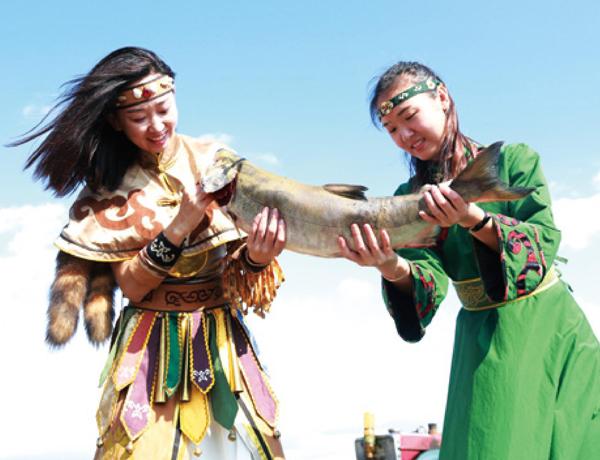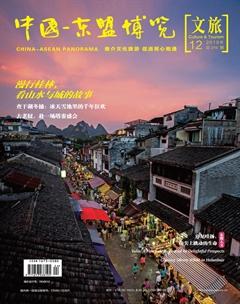Unveiling the Mystery of Fish-Skin Tribe
Mo Tingting



Hezhen people, who make up one of China's smallest ethnic minorities, disperse in the Three River Plain formed by the Heilong River, Songhua River and Wusuli River. The Hezhen are known for their intimate relation with fish. In the past, fish loomed large in their myths and legends and played a major role in their games and sports. They ate fish to the exclusion of almost everything else, wore fish-skin clothing and used products made from fish for their daily needs.
A free fish-skin tribe
The ancestors of the Hezhen people are the Nuzhen, a race of Tartar horsemen who lived primarily in the northern border of several dynasties. In the Qing Dynasty (1644-1911), they were incorporated into the Eight Banners System of the Manchu rulers.
Hezhen people were still in their primitive societal stages even at the beginning of the 20th century. These primitive ways were observed by means of their clothing and way of life. They used to wear clothing made of a variety of fish skins and employed dogs for hunting which earned them the titles “Fish-Skin Tribe” and “Dog-Using Tribe”. The area where the Hezhen people live is known for its green hills, clear water, large rivers and plentiful game and fish. There was an old saying which described how easy the hunting and fishing had traditionally been: “Hezhen people were hunting roes with sticks, scooping fish with gourds, and having pheasant fly into the cooker”. Today, fishing remains the main livelihood of Hezhen who live by the rivers.
Living in an area richly endowed with fish, they have created original skills in fishing through time-tested experience. The Hezhen know clearly when to fish, where to fish, how to fish, and even can tell exactly what species it is. It can be argued that of all the people in the world, Hezhen people are leaders in the number of fishing tools. Their disposal and ways of fishing chores are divided up. When fishing in winter, Hezhen fishermen build a hut on the ice of the river and cut a one-meter diameter hole on the ice. When the door of the hut is closed, it is dark inside the room and bright under the ice, which makes it easy to see the fish and spear them when they come under the hole. In the old days, there were so many fish that the fishermen just sat beside the hole and scooped fish with a strainer. They could collect tons of fresh fish within half a day.
Fish is the staple food of Hezhen people. They have various fish cooking methods. Raw fish, usually sturgeon and carp fish, is a part of their traditional diets. Raw fish is the dish that the Hezhen considers the best to offer to important guests. When making raw fish dish, people cut off the head, skin and bone of the living fish, cut the fish meat into thin slices, and dip the fish pieces into some rice vinegar until the fish pieces turn white. Then they season fish pieces with ginger, salt, green onion and other condiments. This dish tastes refreshing and nutritious, and it doesn't have any unpleasant fish smell. Raw caviar is also a popular dish. It usually comes from the soybean-size jacinth crystalline caviar of salmon or the grain-size green-black caviar of the kaluga sturgeon. Besides, unique methods of having fish also include dried fish bar, dried fish trunk, and dried fish floss.
There was an old saying which described how easy the hunting and fishing had traditionally been: “Hezhen people were hunting roes with sticks, scooping fish with gourds, and having pheasant fly into the cooker”.
Keeping the fish-skin tale alive
Influenced by the Han, Hezhens clothing style resembles the cheongsam. The only difference lies in the material they use. Traditional Hezhens clothing is made of fish skins and deer hides, among which the fish-skin dress is the most distinct, which shows their talent for utilizing natural resources and adapting to the environment.
Fish-skin trousers are wide, trimmed with colored cloth, embroidered with patterns, or decorated with copper bells, which are entirely different for males and females. Those for males are aligned at the upper ends, and the lower ends are edged with black cloth. Fish-skin dress, the national costume worn by Hezhen women, is decorated with shells and colored strips of dyed deer hide in cloud, plant and animal designs. The calf-length dress has loose and short sleeves, with no collar. Bracelets were common ornaments for all women, but only old women wore earrings. When hunting in winter, fish-skin clothing is surprisingly warm and endured the roughest wearing. When fishing in spring and autumn, the fish-skin clothing is as soft as cotton and water-resistant, which can protect the knees and is ideal for people who live around water.
Great care is taken when making fish-skin clothing. Big fish, weighing about 50 kilograms, is good for making fish-skin clothing. Firstly, the full skin of a silver carp or chub is removed and then hung on a door for one night to dry. Then, the scales are eliminated and the skin is hammered down with a wooden mallet to make it as soft as cotton cloth. To avoid damaging the skin, a length of cut bamboo rather than a knife is used for skinning. Secondly, making fish-skin clothing and designing a pattern entirely by hand will take several months to finish. The natural patterns on fish skin give a special shimmering beauty, but it is thick and difficult to penetrate with a needle. Making clothes from this material is hence a complicated, exacting and awkward process. Lastly, the fish skins are sewn together with silver carp skin threads and made into clothes.
In earlier times, Hezhen women would begin work on the dress while their daughters were still children. A wedding gown made of fish skins, however, is a practical garment, being durable and warm as well as ornamental. As dozens of fish skins may be needed to make one wedding gown, Hezhens dressmakers must be punctilious about appropriate matches of shape and color. But the joyful occasion on which a Hezhen mother's handiwork is worn, seen and admired will compensate for all her labors.
Tips
Fish-skin clothing: Nowadays, the tradition gradually receded into a distant memory, and the craft was learned by fewer and fewer people. In 2006, Hezhens method of making clothes with fish skins was listed as a national intangible cultural heritage.

